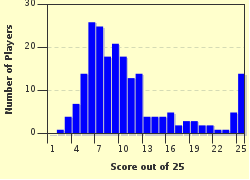Quiz Answer Key and Fun Facts
1. How many combat capable U-Boats were in commission with the Kriegsmarine (KM) at the outset of WWII?
2. On the same day as war was declared by Britain, Kapitänleutnant Lemp of U-30 sank the passenger liner "Athenia" north-west of Ireland. For what else is Lemp known?
3. What policy adopted by the RN at the outset of WWII in regard to German U-Boat activity was quickly shown to be "ahead of its time"?
4. The outset of war found two of the KM's available Heavy Units at sea; which two ships were they?
5. As the war continued, evidence of a very serious flaw in German naval war preparations mounted steadily; to what am I referring with this statement?
6. German military successes in the Spring and early Summer of 1940 gave the Kriegsmarine strategic advantages that their predecessors could only dream of. Our friend Kapitänleutnant Lemp of U-30 rears his head yet again, this time as the first boat to be replenished in France. This occurred on July 7, 1940. Where?
7. The acquisition of ports on the Atlantic coast and in Norway had an immediate impact on the sortie rates of German submarines. The Battle of the Atlantic moved into the first of two periods which later came to be known by the euphemism "Happy Times". Approximately how much tonnage did Dönitz's U-Boats sink in the period from June to October 1940?
8. The Royal Navy found themselves in a difficult position during this period; this contributed directly to the increased success rate enjoyed by the KM. Which of these reasons was NOT a contributing factor in the "destroyer shortage" experienced in the Summer/Autumn of 1940 ?
9. On 31 March 1940 the first of the Kriegsmarine's "Hilfskreuzer" (auxiliary cruisers) set out on what would become an epic cruise. Which ship was she?
10. Although RAF Coastal Command would later play a large role in the defeat of the Kreigsmarine, initial results were very poor. Which aircraft type equipped the bulk of Coastal Command's units early in the war?
11. Who, what, where or when was "The Scourge of the Atlantic"?
12. March of 1941 saw the "odds" catch up to several notable commanders within the U-Boat arm. Who's the odd man out in the following group?
13. July 1941 saw the definite end of the first "Happy Time"; Allied shipping losses plummeted from 300,000+GRT to around 100,000. Which of these did NOT play a factor in this?
14. July-August, 1941 was perhaps one of the most pivotal times in the Battle of the Atlantic. Although officially neutral, the USA was now moving inexorably toward active combat with Germany. Which of these events did NOT take place in this period?
15. In October 1941, the de facto "state of war" between the USA and the Third Reich resulted in the first USN ship lost in the Second World War. Which?
16. The confirmation of the state of war between Germany and the USA saw the U-Boat's focus shifted to the eastern seaboard of the United States. How many U-Boats participated in Operation "Paukenschlag"?
17. On 1 April 1942, the first operational Type XIV (Milchkuh) sailed from Lorient; how many of this type were to see service?
18. In August 1942, advantage in "The Electron War" briefly swung back to the Germans with the introduction of what device?
19. What was the "Biscay Cross"?
20. 1942 was the deadliest year to be a merchant seaman on Atlantic convoy duties. How many ships/tons were sunk by submarines in the Atlantic during this year?
21. The last day of 1942 saw the "Battle of the Barents Sea" fought between heavy elements of the KM and 2 RN 6" (Light) Cruisers. Which of these was NOT a direct result of this battle?
22. In the first half of 1943 it all comes to a head; the result is the decisive defeat of the U-Boat. How many German submarines were in commission by this point in the war?
23. The Allies sat perfectly positioned for Dönitz's increased operational tempo in the Spring of 1943. Which of these was NOT a factor?
24. A favorite of the "what if?" crowd, the Type XXI U-Boats were indeed a remarkable advance in the field. How many were on patrol when Germany surrendered?
25. Which of the following statements about the Type XXI U-Boat is false?
Source: Author
iron2
This quiz was reviewed by FunTrivia editor
bloomsby before going online.
Any errors found in FunTrivia content are routinely corrected through our feedback system.


